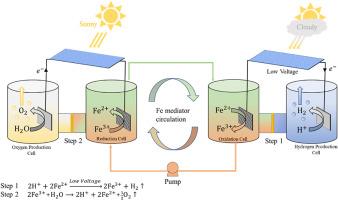基于Fe2+/Fe3+氧化还原偶联的流动型解耦电解系统在波动太阳辐照下制氢
IF 8.3
2区 工程技术
Q1 CHEMISTRY, PHYSICAL
引用次数: 0
摘要
为了克服传统水电解的挑战,如高起始电位,气体交叉以及间歇性可再生能源下的有限稳定性,本研究提出了一种基于Fe2+/Fe3+氧化还原对的流动型解耦电解系统,实现了在低压条件下高效,逐步制氢。Fe2+/Fe3+氧化还原偶对被证明能够在空间分离的电极上实现有效的电子转移,突出了其解耦电解结构的适用性。与传统的质子交换膜电解槽(PEMECs)不同,我们的设计在可变电压条件下保持稳定运行,并与间歇性太阳能发电无缝集成。在50 mA cm−2的电流密度下,其法拉第效率高达98.2%,平均析氢反应(HER)电压比具有相同结构的pemec低0.67 V。值得注意的是,在全太阳光谱下,相应的太阳能制氢效率可以达到20.76%,在多云条件下保持12.7%。此外,该系统具有经济高效的设计,电解质费用比钒基系统低约80%。结合其强大的电化学稳定性和固有的可扩展性,这种配置为分散的太阳能驱动制氢提供了一种很有前途的方法。本文章由计算机程序翻译,如有差异,请以英文原文为准。

A flow-type decoupled electrolysis system based on Fe2+/Fe3+ redox couple for hydrogen generation under the fluctuating solar irradiation
To overcome the challenges associated with conventional water electrolysis, such as high onset potential, gas crossover, and the limited stability under intermittent renewable energy sources, this study presents a flow-type decoupled electrolysis system based on the Fe2+/Fe3+ redox couple, enabling efficient, stepwise hydrogen production under low-voltage conditions. The Fe2+/Fe3+ redox couple was demonstrated to enable efficient electron transfer across spatially separated electrodes, highlighting its suitability for decoupled electrolysis configurations. Unlike traditional proton exchange membrane electrolyzer cells (PEMECs), our design maintains stable operation under variable voltage conditions and seamlessly integrates with intermittent solar energy generation. It achieved a high Faradaic efficiency of 98.2 % at a current density of 50 mA cm−2, with an average hydrogen evolution reaction (HER) voltage of 0.67 V lower than PEMECs with the same structure. Notably, the corresponding solar-to-hydrogen efficiency could reach 20.76 % under the full solar spectrum and maintain 12.7 % under the cloudy conditions. Moreover, the system features a cost-effective design, with electrolyte expenses approximately 80 % lower than vanadium-based systems. Combined with its robust electrochemical stability and inherent scalability, this configuration offers a promising approach for decentralized, solar-driven hydrogen production.
求助全文
通过发布文献求助,成功后即可免费获取论文全文。
去求助
来源期刊

International Journal of Hydrogen Energy
工程技术-环境科学
CiteScore
13.50
自引率
25.00%
发文量
3502
审稿时长
60 days
期刊介绍:
The objective of the International Journal of Hydrogen Energy is to facilitate the exchange of new ideas, technological advancements, and research findings in the field of Hydrogen Energy among scientists and engineers worldwide. This journal showcases original research, both analytical and experimental, covering various aspects of Hydrogen Energy. These include production, storage, transmission, utilization, enabling technologies, environmental impact, economic considerations, and global perspectives on hydrogen and its carriers such as NH3, CH4, alcohols, etc.
The utilization aspect encompasses various methods such as thermochemical (combustion), photochemical, electrochemical (fuel cells), and nuclear conversion of hydrogen, hydrogen isotopes, and hydrogen carriers into thermal, mechanical, and electrical energies. The applications of these energies can be found in transportation (including aerospace), industrial, commercial, and residential sectors.
 求助内容:
求助内容: 应助结果提醒方式:
应助结果提醒方式:


